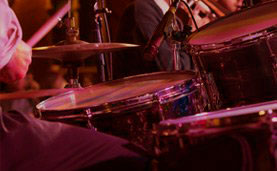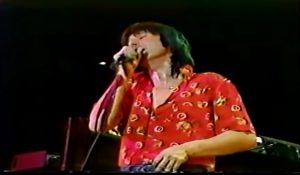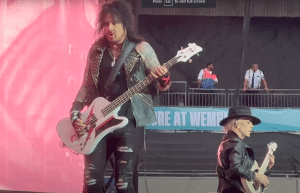The Untold Story of AC/DC’s Ferocious 1977 North American Run

Angus Young - official AC/DC YouTube
AC/DC entered 1977 as a determined young band with a growing reputation in Australia but limited exposure elsewhere. The release of Let There Be Rock positioned them for a wider audience, and the timing proved crucial. Four days after the album appeared in the United States, the band set foot on American soil for the first time, stepping quietly into a country that had no idea what was about to hit it. Their arrival marked the beginning of an early chapter that would later define their climb from cult act to hard-rock power.
Preparation for the tour had been careful and calculated. Before leaving Sydney, AC/DC played two unannounced shows at the Bondi Lifesaver under the aliases The Seedies and Dirty Deeds, sharpening their set for the American push. At the same time, Atlantic Records restructured its promotional department, bringing in a new team that quickly recognized the band’s potential. Early internal skepticism gave way to enthusiastic support once the label viewed performance footage highlighting AC/DC’s raw energy and Angus Young’s unhinged stage presence.
The strategy became simple: put the band in front of as many audiences as possible. Atlantic’s promotional department believed the turning point would come from relentless touring, not radio play, which remained elusive due to the band’s provocative lyrics. That belief set AC/DC on a road schedule that would stretch across two years. The 1977 run represented only the start of that crusade, but it offered the first glimpse of how American crowds would respond when confronted with the band’s uncompromising live attack.
A Quiet Arrival and a Thunderous First Impression
AC/DC arrived in the United States on July 27, 1977, slipping into the country with none of the fanfare seen in previous British invasions. There were no airport crowds or press photographers; instead, the group piled into a used station wagon and began navigating the vast distances between early tour dates. Their initial shows placed them as openers for Moxy, giving American audiences a first look at the band’s blistering approach to hard rock.
Texas proved to be an unexpectedly fertile starting point. Audiences in Austin, San Antonio, and Corpus Christi responded immediately, connecting with Bon Scott’s swagger and Angus Young’s high-voltage performance style. A free radio-sponsored show in Dallas cemented their early momentum, drawing a packed crowd and signaling to Atlantic that the live strategy was working. The band’s chemistry on stage—loud, lean, and relentless—translated effortlessly even for listeners unfamiliar with their records.
From Texas, the tour pushed east into Florida. A canceled Gainesville appearance briefly halted the schedule, but the following nights with REO Speedwagon drew strong attendance and hinted at growing word-of-mouth. Jacksonville became the breakthrough moment. Local radio placed several AC/DC tracks into rotation, and suddenly the band jumped from earning modest club fees to performing in front of 8,000 fans at the Coliseum. This early surge in enthusiasm demonstrated how quickly the tour could ignite regional support.
Hard Miles, Bigger Stages, and A Rising Reputation
After their Florida dates, AC/DC pressed deeper into the American heartland. A charity appearance in Hollywood, Florida—drawing more than 13,000 people—showed that the band’s buzz was spreading rapidly. Subsequent shows found them opening for established acts like Foreigner and UFO, exposing the group to even larger audiences. Venues such as Mississippi Nights in St. Louis and Memorial Hall in Kansas City placed AC/DC in front of crowds that were not necessarily seeking them out, yet the band consistently left an impression.
The tour’s middle stretch demonstrated the effectiveness of their live-first approach. Performances in Illinois, Ohio, and across the Midwest revealed that even club audiences responded as strongly as arena crowds. Nights at the Agora in Columbus, where they opened for The Dictators, showed AC/DC’s ability to dominate stages regardless of their placement on the bill. Their gritty, stripped-down sound translated clearly in small venues where sheer volume and attitude reshaped the atmosphere instantly.
As the band moved north toward Wisconsin, its reputation as a formidable touring act grew louder. Letters sent home by Bon Scott described an America that embraced them with enthusiasm—particularly the local nightlife. While still far from mainstream recognition, AC/DC was developing a network of regional support. These early shows laid the foundation for markets that would later become strongholds, proving that persistence, rather than immediate fame, would drive their American ascent.
A Historic Night in Madison and the End of an Era Elsewhere
By August 16, 1977, AC/DC arrived in Madison, Wisconsin, for what would technically be their fourteenth performance on the tour. The date itself carried a weight no one could have predicted. Earlier that day, news broke that Elvis Presley had died at his Graceland home in Memphis, signaling the end of a defining era in American music. While much of the country was processing the loss, AC/DC was preparing to take the stage at the Stone Hearth, unaware that the night would place them at an unusual moment in rock history.
The band’s performance in Madison represented the meeting point between rock’s past and its future. While Elvis’s passing dominated headlines, AC/DC delivered a show shaped by urgency, grit, and the need to win over every room. Their relentless touring philosophy meant no night could be treated as routine, especially in a bar-sized venue where the crowd stood only feet away from the amplifiers. This contrast underscored how dramatically the landscape of live rock had shifted since Presley’s prime.
That August evening now stands as a symbolic turning point in retrospect. As the curtain fell on the final chapter of one rock icon’s story, AC/DC was in the earliest stages of writing its own. The 1977 run, fueled by long drives, club stages, and relentless determination, hinted at the band’s coming rise. The tour not only introduced American audiences to a new force but also marked the moment when AC/DC began carving out the enduring legacy that would define the next era of hard rock.













